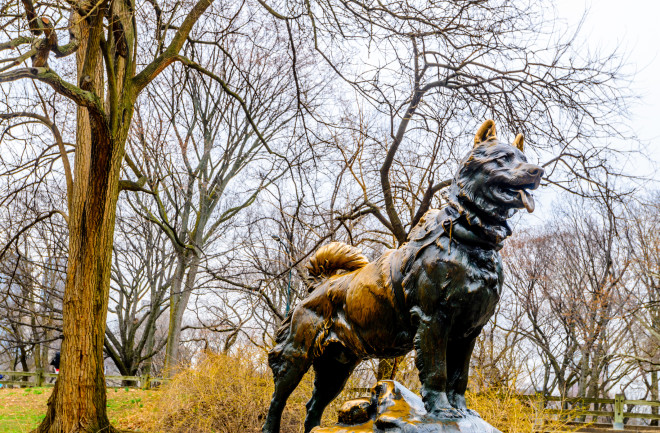Whether you’ve watched the beloved animated film or walked past his statue in Central Park, there’s a good chance you’re familiar with Balto the sled dog.
Long believed to be a Siberian husky, Balto — perhaps the most famous sled dog of all time — gained superstar status for his role in delivering diphtheria medication to sick children in Nome, Alaska, in 1925. Now, scientists have analyzed his DNA, comparing his genome to the genomes of nearly 700 dogs and wolves to reveal how Balto stacks up against modern canines.
“We can use those comparative resources to see where Balto is different and where he’s the same,” says Katherine Moon, one of the study’s authors and a genomicist at the University of California, Santa Cruz. “And what do those genes likely do, and what does that mean for what Balto may have looked like or how well he ran.”
The results of the analysis, published in Science in 2023, reveal that the famous canine was a blend of different Asian and Arctic breeds — and more genetically diverse than dogs today. What’s more, the attributes coded in those genes likely helped sled dogs like Balto survive the extreme conditions of the subarctic.
Is Balto the Sled Dog a True Story?
It’s been immortalized in books and movies for nearly a century, and Balto’s tale is indeed true. Born in 1919, he was named after Sàmi explorer Samuel J. Balto, who was part of the first team to trek across the Greenland ice cap.
Then, in early 1925, Balto was part of a relay of sled dog teams who hauled diphtheria antitoxin to Nome, where an outbreak was spreading among the town’s children. The dogs and their human drivers, including musher Gunnar Kaasen, battled blistering whiteouts, freezing temperatures, and fierce winds on the 674-mile-journey to deliver the medicine; they arrived without breaking a single vial.
Along with Balto, a dog named Togo led his team through the longest and most dangerous part of the journey. The antitoxin may never have made it to Nome if it wasn't for both of these dogs.
Several years later, in 1927, Balto and his teammates were ferried to Cleveland, Ohio, where they were given a parade and taken to their new home at the Brookside Zoo. After Balto’s death in 1933, his body was preserved and mounted at the Cleveland Museum of Natural History, where it remains on display today.
What Did We Learn from Studying Balto’s Genome?
By plucking tissue from Balto’s taxidermied remains, the scientists were able to extract his ancient DNA and then sequence the dog’s genome. The results provide a glimpse of a time before we started breeding dogs to look a certain way.
Read More: The Cost of Cuteness: Do Selective Breeding Practices Harm Dogs?
“You expect some damage, and we did see damage, obviously, because he is 100 years old,” says Moon. “But he was actually fairly well-preserved for a taxidermied specimen.”
In the end, the researchers found that Balto was more genetically diverse than modern dogs, sharing only part of his ancestry with Siberian huskies. Beyond that, he was less inbred than modern breeds and had fewer genetic variants that could cause health issues.
The study authors were also able to reconstruct what Balto looked like from his DNA alone, predicting details like his coat color (black, with bits of white), eye color, and the thickness of his fur. They then matched those predictions with historical photos and Balto’s taxidermied remains.
“We found that it was dead-on; really accurate,” says Moon. “That was pretty cool.”
Ultimately, the paper provided the study authors with a rare opportunity to check their DNA analysis against what we know about the original specimen.
"That really is the strength of this paper, in general," says Moon. "Aside from the fact that Balto was a very good boy, and we can all agree on that."
What Made Balto So Special?
Fittingly, Balto's genes also included variants that may have helped him and other working dogs weather harsh environments. (Or, say, pull a heavy sled across the frozen tundra.) For example, the researchers found variants that may have helped sled dogs grow strong bones and muscles, as well as a thick coat.
Read More: How Dogs Have Uniquely Co-Evolved With Humans Like No Other Species
“[Balto] was enriched for these variants that you would expect a dog of his population to need,” says Moon. “A dog a hundred years ago probably needs things like thick skin and thick fur and things like that.”
While Balto's DNA revealed that he had no wolf ancestry himself, he may have been somewhere in between wolves and modern dogs: The specimen suggests he was better at digesting starch than wolves and Greenland sled dogs, but not as well as modern breeds. (Starch is a common ingredient in both dry and wet commercial dog foods today.)
Why Is This Work Important?
The expansive work on Balto’s genome — alongside detailed DNA analysis of 682 other dogs and wolves — could help scientists unravel new insights about canine evolution, such as when domesticated dogs first emerged and arrived in North America.
The work is part of a larger international effort called the Zoonomia Project, a database that allows scientists to compare genetic material from 240 mammalian species, including horses, humans, ground squirrels, and, yes, even Balto. Scientists hope that the repository can drive new insights about how different species align genetically — and help us learn more about ourselves, too.
“I hope that Balto offers a bit of a guide through genomics,” says Moon. “It can be impenetrable; it’s a very difficult to visualize science. So I hope that Balto acts as a gateway for people to really see what can be done. We’re starting to adventure on the leading edge of comparative genomics, and that adventure includes everybody.”
Read More: Wolves Keep the U.S. Ecosystem in Check

